The World Economic Forum’s IoT Guidelines for Sustainability report states that 84% of IoT deployments are addressing, or have the potential to address, the UN’s Sustainable Development Goals. These SDGs include combating climate change, sustainable production patterns and ensuring availability of clean water.
But as the report points out, “No services are possible without the infrastructure in place. Particularly in the case of IoT, at some point in the future revenues may come from the services associated with data, but without addressing the infrastructure solutions first, that day is still far away.”
In this post, we’re exploring challenges that are preventing the roll-out of IoT solutions in the areas that need it most, and offering some ideas to resolve these issues. It’s not a fully comprehensive list of challenges. We’ve left out the issue of national and municipal government buy-in, and conflict / war zones, as while they’re unquestionably barriers, we’re realistic about the ability of a blog post to provide a practical solution to them!
The two barriers to IoT infrastructure we’re addressing are affordability and geography.
Where in the world is the lack of IoT infrastructure most acute?
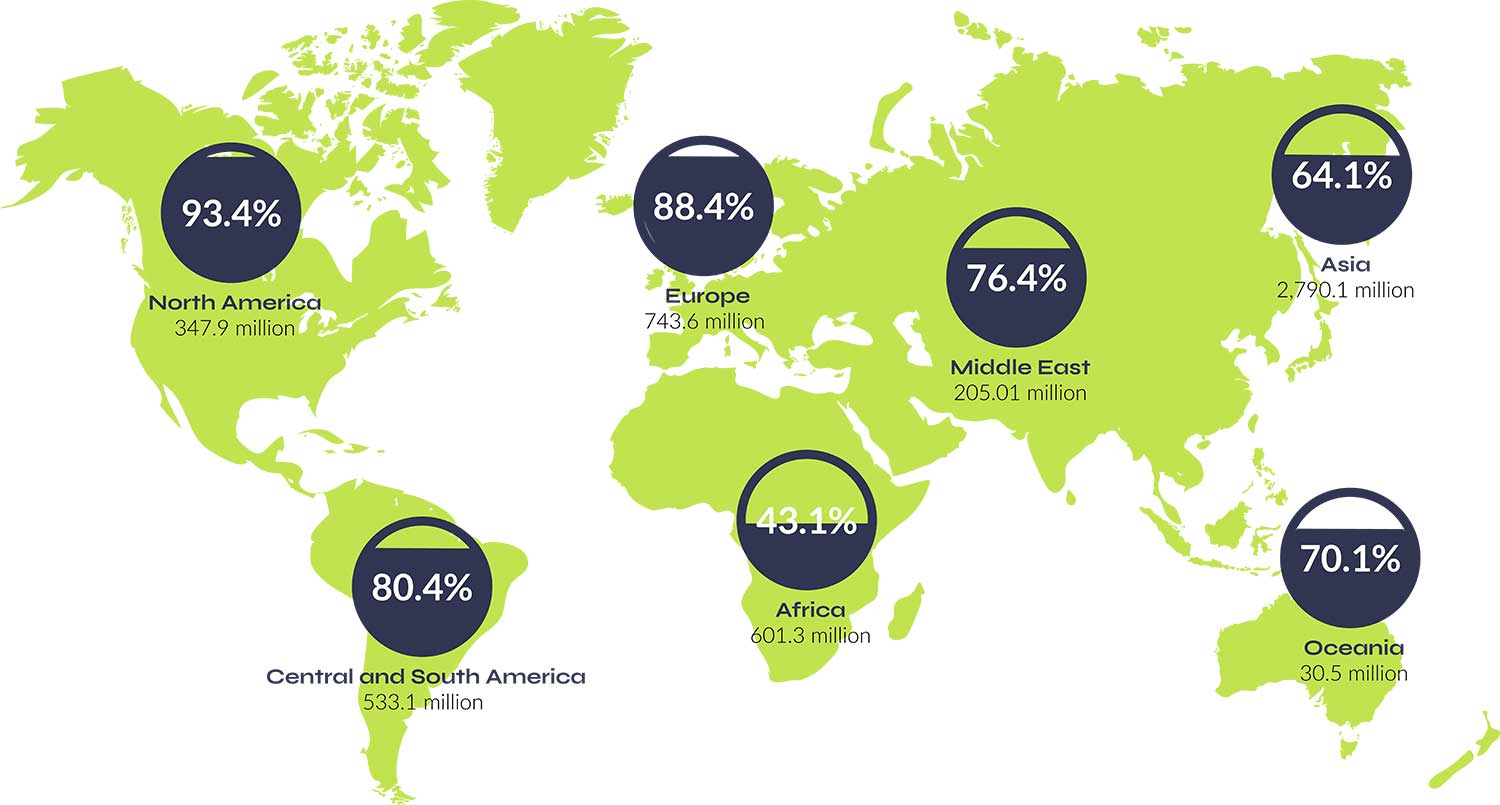
This graphic illustrates the impact of the digital divide. This relates to the gap between demographics and regions that have access to modern information and communications technology, and those that don’t. The statistics are shocking: 43% of Africans can use the internet, compared to 93% of Americans and 88% of Europeans. Even in more developed regions like the Americas, four out of 10 Latin Americans in rural areas have no way to connect to the internet (source) – because terrestrial networks are prohibitively expensive to set up in non-densely populated areas.
And the digital divide doesn’t only affect individuals’ access to the internet. The lack of infrastructure also means businesses and governments can’t deliver the benefits of IoT connectivity: improvements in energy efficiency; healthcare outcomes; public safety; environmental monitoring; transport planning; agriculture sustainability – the list goes on.
As just mentioned, the main reason for this is that cellular networks rely on a dense network of base stations and antennas to provide coverage, which is expensive and challenging to deploy, and there’s limited financial incentive for the private sector to support this outside of urban areas.
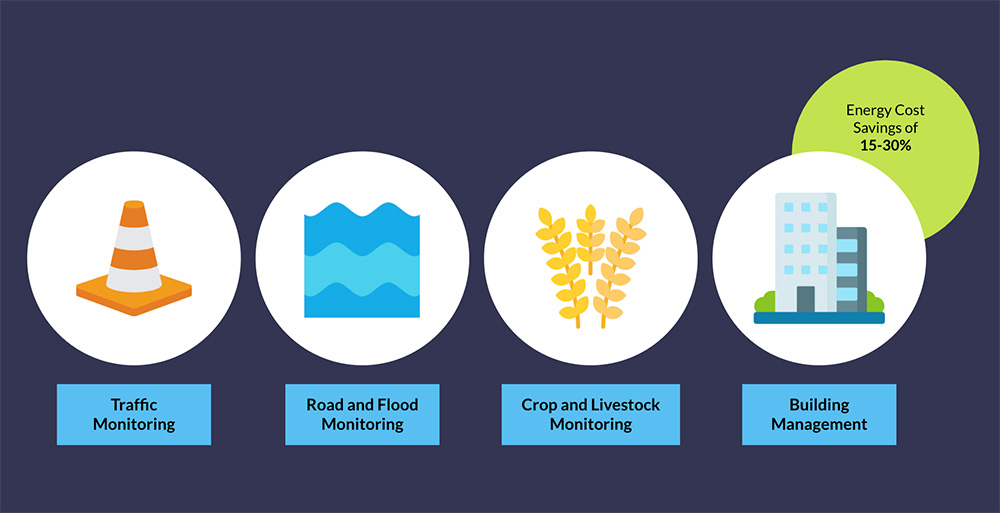
One proposed solution to the IoT connectivity challenge is to create coverage through LPWAN technology. A group of academics in the United States received funding for just such a project in 2021, with the goal of enabling small communities in upstate New York to benefit from IoT applications including remote meter readings for utility firms; traffic monitoring; real-time road and flood monitoring; crop and livestock monitoring for farmers, and building management.
Early returns for the latter indicated energy cost savings of between 15-30%; great news for the bill payer and the environment alike (source).
While there’s a lot to recommend this, there are a couple of additional considerations: firstly, the gateway that controls the network and aggregates the data from the nodes needs to be able to connect to the cloud, and for that it needs another means of connectivity. If you can position your gateway within cellular coverage, adding a cellular modem to your gateway will resolve this challenge. If you are out of cell tower range, a satellite modem such as Ground Control’s RockREMOTE will have the same effect.
The second consideration is mobility: neither of the two most popular LPWAN technologies – NB-IoT and LoRaWAN – were intended for mobile applications such as fleet monitoring or animal tracking. LoRaWAN can be used to connect moving sensors, but there’s a greater risk of transmission interference as a result of signal collision if a large number of nodes are connected (read more). This has an associated effect of increasing the energy consumption as packets are retransmitted, and changes in device location sometimes resulting in a higher spreading factor (SF).
To solve the mobility issue in areas with no terrestrial infrastructure, you may want to explore satellite transceivers, but be sure to look for devices with omni-directional antennas with no requirement to ‘point’ them at the satellite network overhead. The tiny RockBLOCK 9603, which transmits very small packets over the Iridium network, is ideal for sensor data transmission from animal tracking collars, UAVs, and drifting data buoys. If you need to send and receive higher volumes of data, something like the RockREMOTE Rugged works well for heavy machinery monitoring and control, including autonomous tractors and mobile generators.
But isn’t satellite IoT prohibitively expensive?
Satellite IoT has experienced a huge growth in demand and service providers as – largely thanks to Space X – the cost of launching a satellite has decreased from $85K per KG in the 80s to just $1K per KG in 2020 (source). This means plenty of competition and service diversification, which has driven down costs. As an example of this, a customer of ours, Synnefa, facilitates remote farming for smallholders in Kenya.
By providing them with accurate, real-time data on soil moisture, temperature, nutrient levels in the soil, and light intensity, Synnefa enables these remote farmers to optimise productivity while reducing waste, and it’s working:
- 50% Water savings
- 41% reduction in fertiliser usage
- 30% increased production.
Synnefa uses terrestrial connectivity where available, and Kenya is better connected than much of Africa, but as the map shows, there are huge swathes of agricultural land that have no access to cellular networks. So the Synnefa team ship their FarmShield device with a RockBLOCK 9602; if the sensor is out of terrestrial communication range, it can use satellites to send data.
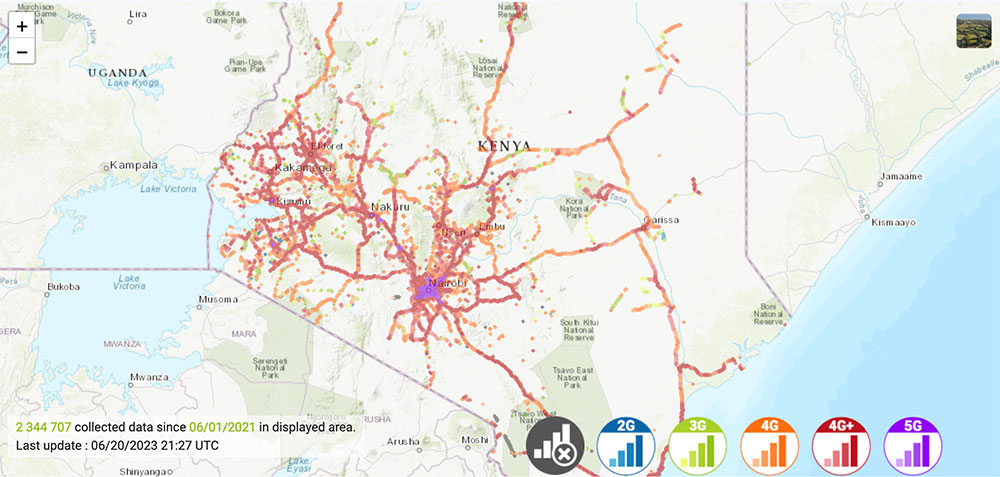
But the critical point here is that Synnefa charge their customers no more for cellular than they do for satellite; there is a difference in cost to Synnefa, but it’s not so significant that they have to pass it on. Synnefa’s customers can benefit from more sustainable and productive farming wherever their farm is located.
Satellite connectivity continues to get more affordable, and we’re excited to watch the progress of SatelioT who are in the process of launching nanosatellites into Low Earth Orbit just 500 KM above us; that’s so close they don’t even need an antenna to create terrestrial connectivity. The purpose of these nanosatellites is to act as telephone towers in space, extending the reach of 5G NB-IoT connectivity to basically anywhere on Earth. So in principle, and hopefully soon in practice, you’ll be able to connect your IoT device to this Non-Terrestrial-Network (NTN) without needing an additional transceiver or antenna. This would be a huge step forwards for isolated communities, and with no new hardware needed, would greatly speed up the introduction of remote monitoring applications.
As with all of these newer entrants, including Swarm (now owned by SpaceX), who’s probably the best known of the nanosatellite manufacturers, it’s worth noting that for at least the next 2-3 years, the frequency with which your device will be able to send and receive data will be much slower than established satellite constellations like Iridium or Inmarsat. This is because there are simply fewer satellites overhead, so you’ll need to wait longer before your device signal is picked up. And you’ll also need to check if the region you’re aiming to connect is covered by an orbiting satellite, as few satellite operators have truly global coverage. But if you have coverage, and your application can manage with store-and-forward delivery, these are low cost options that may hold the key to unlocking some missing infrastructure and financing challenges.
IoT can help combat climate change – but climate change is making it harder to create IoT infrastructure
Another barrier to leveraging IoT for sustainable development is the increased frequency, duration and magnitude of extreme events, including droughts, flooding and extreme heat. And the countries most likely to be affected by these conditions are often the countries with the least ability to adapt. Projections indicate that Sub-Saharan Africa will bear the brunt of climate change impacts on food security, due to its reliance on rain-fed agriculture. Projects such as solar irrigation, rainwater harvesting and irrigation systems will be essential to enhance water availability, but their efficacy is limited without sensors.
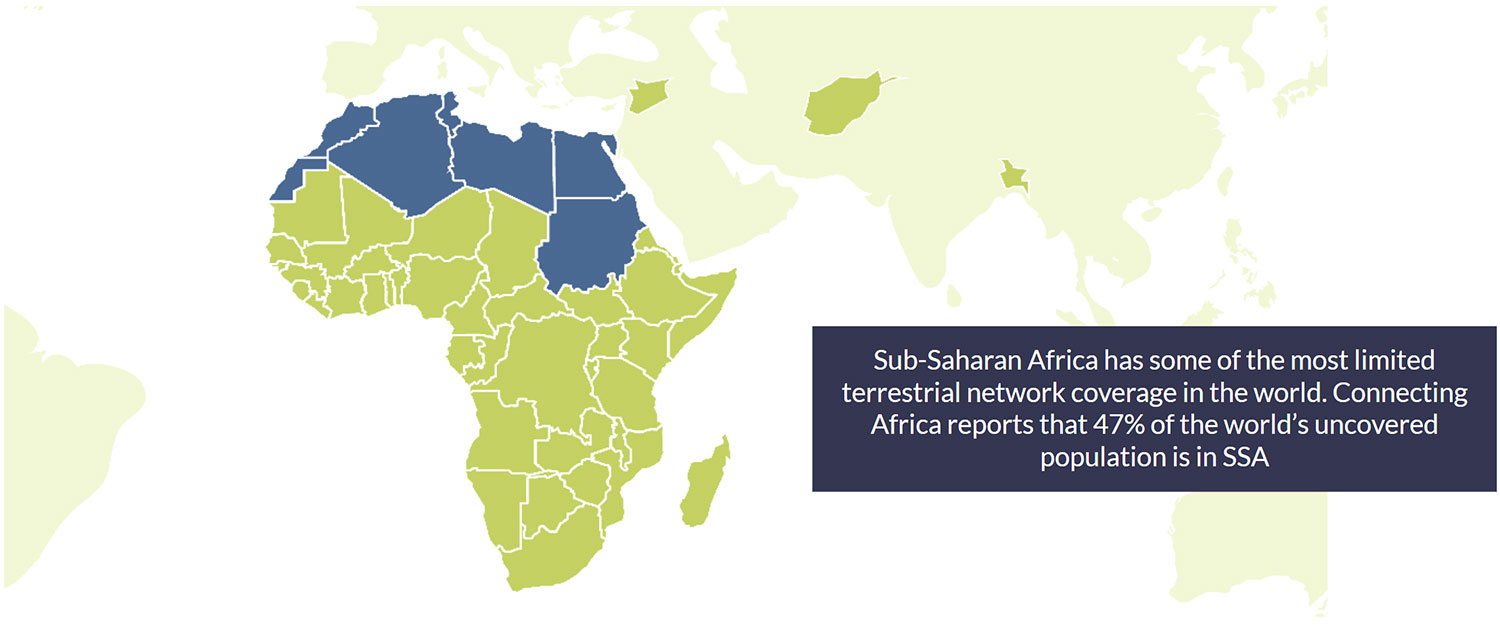
Knowing what resources you have, where they are, and where and when they’re most needed is fundamental to the successful deployment of smart irrigation technology. You can send someone to gather and report sensor data, or you can utilise IoT to get real-time data, and vastly speed up your reaction time to new data, while better modelling future needs. Sub-Saharan Africa, however, has some of the most limited terrestrial network coverage in the world. Connecting Africa reports that 47% of the world’s uncovered population is in SSA (source).
Further, terrestrial networks where they do exist are susceptible to natural disasters; flooding, hurricanes and earthquakes and ensuing landslides can create power outages and damage cell towers; fibre ducts can become waterlogged; repairs can be delayed due to road damage. In 2022, 1,200 cell towers were impacted in South Africa alone due to a prolonged spell of heavy rain and the ensuing flooding and landslides (source). In developing countries, infrastructure such as the electricity grid and piped water are often the responsibility of county-level or national government, and it can take years before damage is rectified. One study in Kenya found that 62% of electrical grid failures caused by floods were never repaired (read more). This presents massive challenges for IoT deployment that relies on terrestrial communication networks like BLE, WiFi and Cellular.
So, we turn again to the twin options of LPWAN – specifically LoRaWAN here, because of its independence from 4G / 5G cellular tower infrastructure – and satellite; sometimes deployed separately but often combined to provide low cost coverage over a wide area, with no dependency on terrestrial networks for data backhaul.
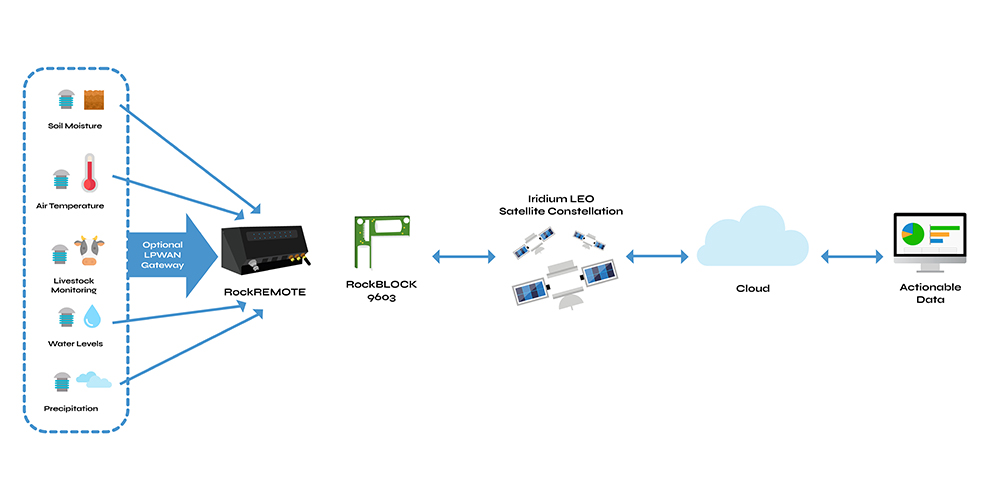
Neither of these options are immune to damage but they are more resilient. LoRaWAN gateways are, of course, much smaller than cell towers, and the signal is largely unaffected by wind and rain. They’re available in IP68 rated enclosures with automated leak detection and remote configuration options – essential if you’re not going to be able to reach the device for long periods of time.
Similarly, satellite transceivers are often built into highly ruggedised enclosures, or are shipped with such enclosures. Some are solar powered; others will work off a single battery for years. Devices like the RockREMOTE Rugged also support Over The Air (OTA) device configuration. Paired with a sensor array or data logger, you’ve got a IoT solution that is highly resilient against adverse weather, as the transmission is going to, or being received from, satellites orbiting far above the Earth (some not as far as they used to be, but still well out of trouble!). The ground stations used by satellite network operators are carefully chosen for their stability and security; it’s why satellite connectivity is so often deployed in emergency situations, when terrestrial networks have failed.
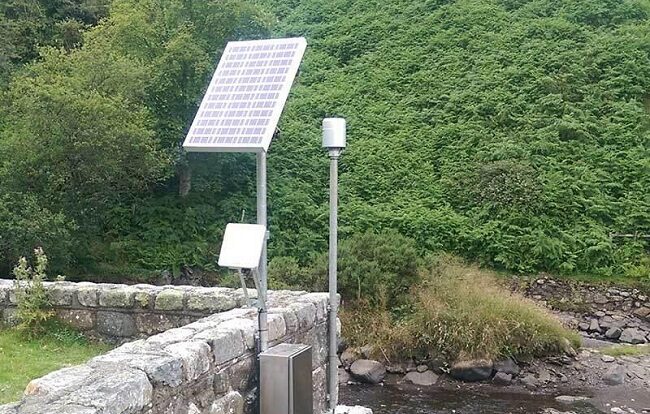
Leading renewable energy provider RWE has installed hydrology stations which monitor water levels, precipitation, air and water temperatures, and relative humidity, to detect excess rainfall in remote parts of Wales, UK. These hydrology stations are located at hydroelectric power stations; reservoirs which pipe water through turbines to supply renewable energy to the grid.
If there’s excessive rainfall, the operators can push more water through the turbines, which provides more green energy; and there’s a huge added benefit in that this also greatly reduces the chances of localised flooding, as the reservoir’s capacity to absorb more water grows.
In the complete absence of cell towers – this being a particularly beautiful and remote part of the UK – these hydrology stations use satellite connectivity, in this case Viasat IoT Pro, to transmit the data in real-time back to the operations centre. The cost is managed through edge computing, which allows the frequency of transmission to be increased to every 15 minutes if data falls outside of normal parameters, but is usually set to transmit every 3 hours.
In summary, the places that would benefit the most from IoT to help with sustainable development goals are often the places most under-served by terrestrial networks – because it’s too difficult, too expensive, or too risky to install them. Outside of urban areas, coverage in Africa, Asia and Oceania is extremely limited, and yet these regions are some of the most at-risk from rising sea levels, drought, flooding and other extreme weather conditions.
In order to bridge the digital divide, we need to look to low cost, resilient and easy to deploy connectivity solutions. Some are available today – LoRaWAN and satellite IoT, both combined and independent of each other, are entirely viable options. And it’s very exciting to see what’s coming in the next few years from innovations which will bring satellite and cellular networks together.
Would you like to know more?
We design and build our own satellite transceivers, and also work with trusted third parties to offer a wide range of connectivity options and airtime partners.
